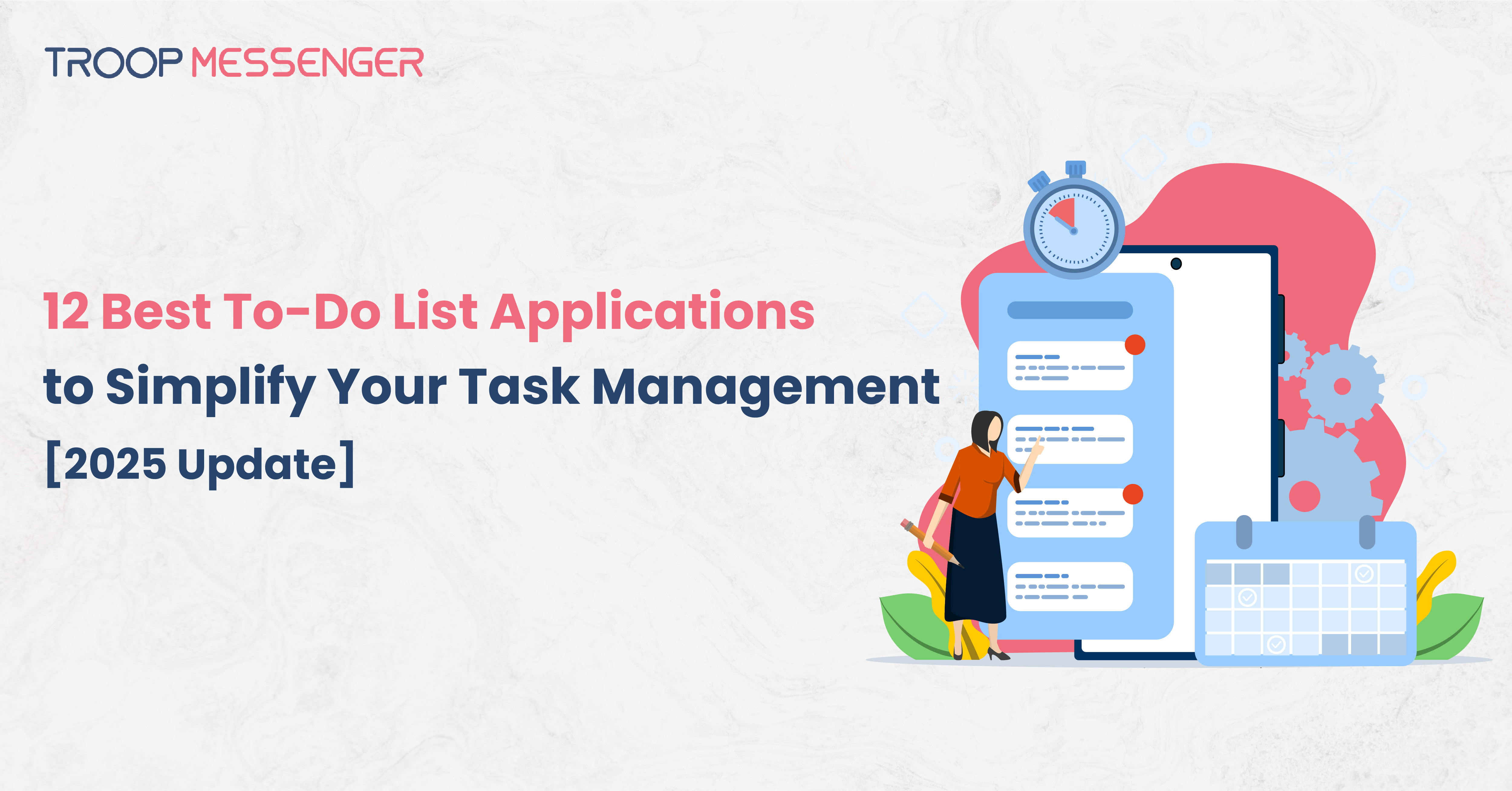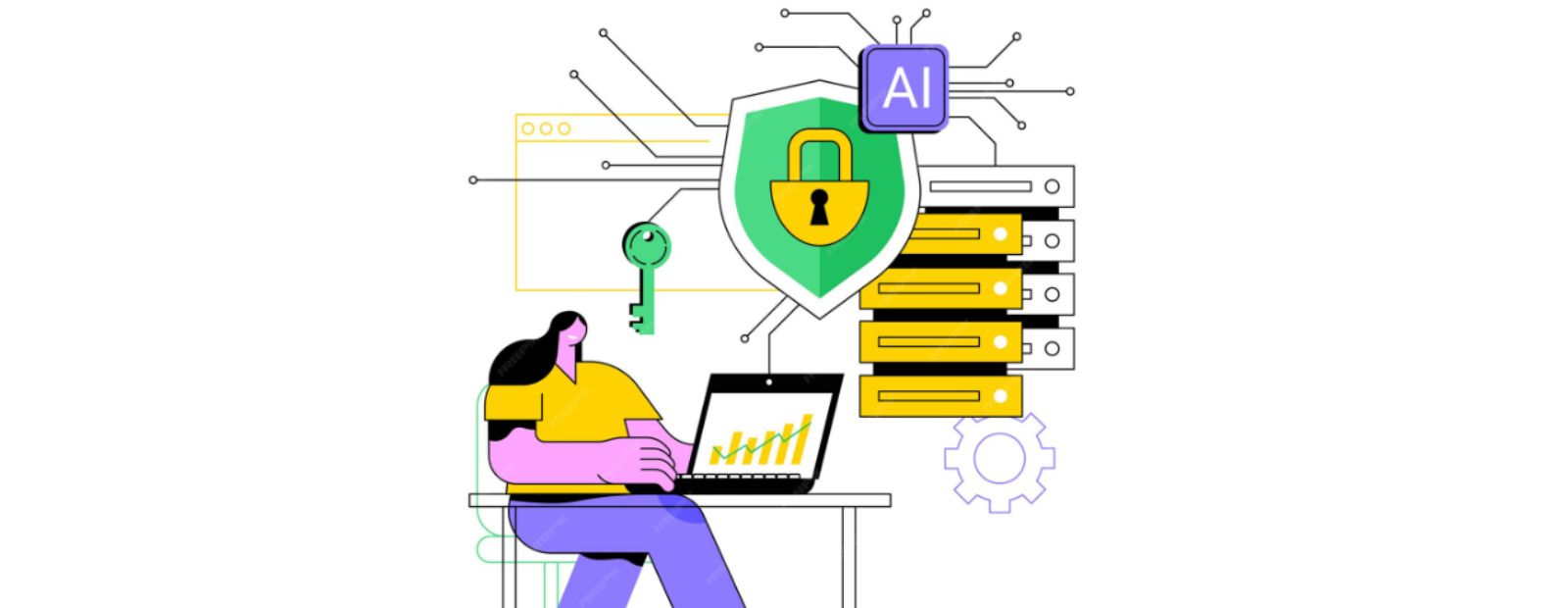Connect with us

12 Best To-Do List Applications to Simplify Your Task Management [2025 Update]
Task management software has become an important part of everyone's productivity arsenal. As our lives have increasingly become hectic, it becomes harder and harder to keep track of everything that needs to get done.
To solve this issue, there are numerous apps for task management, to-do list software, project management software, list-making apps, note-taking apps, team communication tool, team collaboration software, instant messaging apps, and to-do list management, etc. that boost employee motivation. Indeed, it is good to have team collaboration software like Troop Messenger, which comes with extensive task management(upcoming) ability for helping project teams organize their sprints within it seamlessly.
Some of the best to-do list applications of the year 2024 are:
To-Do-List Applications
1. Any.Do
Any.do is an online to-do list management tool that helps users to organize their tasks and goals. It is an all-in-one tool that helps you manage all the tasks in a single app. It is a to-do list application that is popular for its simplicity and ease of use.
Key features:
- It has quickly become one of the most used tools in productivity circles because it provides an effortless way to manage big and small tasks.
- Whether you are new to working on your tasks or need a quick fix for getting things done, Any. do can help you get organized and stay focused on what is important.
Pros and cons: It is user-friendly but there is no option to add sub-tasks.
Cost: It is available as a free and premium subscription.
2. Microsoft To-Do
Microsoft To-Do is a great tool for task management and managing to-do lists. It is software that helps users plan, manage, and communicate projects. Creating one email on Microsoft gives access to several tools and applications. One such tool is Microsoft to do. Creating, modifying, and deleting tasks are easy for Microsoft to do. The benefits of using Microsoft to do are manifold.
Key features:
- It helps users to manage their tasks and achieve their goals.
- It is a cloud-based technology that can be accessed from any device.
- The software has a modular structure, making adding new features easy.
- It also has a drag-and-drop interface that makes it easy to manage tasks.
Pros and cons: Adding details to tasks is easy while syncing is not always reliable.
Cost: Microsoft to do is free.
3. Todoist
Todoist is a to-do list app popularly used by busy people who want more control over their time.
Key features:
- It allows users to create, label, and prioritize tasks with the help of natural language processing features.
- The software comprises different modules, including Tasks, Notes, Due Dates, and Labels.
- The Tasks module helps users to manage their tasks and priorities.
- The Notes module allows users to take note of the information related to the functions.
- The Due Dates module will enable users to schedule the lessons and track their progress.
- The Labels module helps users to categorize the tasks.
Pros and cons: Todoist also provides context-sensitive notifications that let you know when a job has been completed or updated. One drawback is that tasks once done do not appear again.
Cost: Three plans are available, free, pro at $4/month if billed annually $5 if billed monthly. Free trial of 30 days after which $7 is charged per month if billed annually or $8 if billed monthly.
4. nTask
One of the most popular to-do list task management software is nTask. It is a task management system designed for productivity.
Key features:
- nTask allows users to create, organize, and prioritize their tasks with ease.
- It has various features that make it an excellent choice for anyone looking for a tool to help manage their tasks and keep track of what needs to be done.
- It allows users to manage their tasks by creating, tracking easily, and sharing tasks with others.
- It also offers optional notifications for tasks that have been completed, conflicts that have been resolved, and other important updates.
Pros and cons: The features are easy to use but users complain of difficulty in using the tool and of occasional glitches.
Cost: There is a free version and the premium plan is $3 per month.
5. Asana
Asana is used to making to-do lists that allegedly enhance organizational skills. It is a task management software that allegedly enhances productivity. Asana allows users to manage their tasks efficiently and collaboratively, which helps them achieve their goals more quickly.
Key features:
- It also includes tools that allow you to add items directly to the list and set due dates and reminders so that everything stays on schedule.
- Additionally, it offers export capabilities so users can easily share lists or even import them into other applications if desired.
Pros and cons: While being a great tool for management, many features are only available in the premium version.
Cost: Asana free, premium, and business plans are available. Premium is $ 11 per month if billed annually or $ 13.50 if billed monthly. Business is for $25 if billed annually and $ 30.50 if billed monthly.
6. Habitica
Habitica is online to-do list software that helps users to monitor their tasks and map their progress. The software also provides tools for goal setting and tracking progress.
Key features:
- It allows users to create custom lists, add notes and reminders, set deadlines, and share tasks with others.
- It is a task management software that also allows users to record their progress and find information about the tasks they have completed.
- It also has a feature called "The Board," which is a visual representation of the user-do list.
Pros and cons: Habitica is a great tool to instill the habit of being organized and completing tasks among children as this app makes tasks appear like games.
However, due to their nature, the tasks might not be taken seriously and few features are available for elaborating tasks.
Cost: $5 every month, $15 every three months, $ 30 every six months, and $ 48 every year.
7. Infinity
In the modern technological age, a computer is one of the most common tools used by people of all ages. Infinity tool improves team collaboration features for team productivity. The infinite tool makes it easy for users to prioritize their tasks and meet deadlines. The intuitive user interface makes it simple for anyone to use the software regardless of experience or skill level.
Key features:
- The infinite tool makes it easy for users to prioritize their tasks and stay on top of deadlines.
- The intuitive user interface makes it simple for anyone to use the software regardless of experience or skill level.
Pros and cons: While the tool has a great UI, it is not customizable according to needs.
Cost: There are many plans available according to the size of the business.
8. Trello
Trello is a popular task manager app that has gained immense popularity over the years because of its intuitive and user-friendly interface. It is among the perfect task management apps for people who want to get their work done efficiently.
Key features:
- It is software that helps users plan, manage, and communicate projects that allow users to add cards with specific information (text, photos, files) and then assign them to collaborators.
- It is used to visualize and manage workflow.
- As Trello grows more complex by allowing users to create boards that include lists and items within lists, it becomes an even better tool for organizing larger projects.
Pros and cons: The fact that Trello integrates well with other productivity tools such as Dropbox or Gmail makes it even easier for people constantly working on several projects at once. Trello is a perfect task management software for people who want to get their work done efficiently.
Even though Trello provides enough features, it lacks high storage facility and some basic features like editing posted comments.
Cost: Trello consists of various plans like free, a standard for $5 if billed annually or $6 monthly, the premium for $10 if billed annually or $12.50 monthly, and enterprise for $ 17.50 every month and $210 annually.
9. Smart Task
SmartTask tools can be used to help with productivity. They are designed for people who have a lot of jobs to complete and who want to be able to focus on the most important ones. Smart task tools are often categorized to boost business productivity.
Key features:
- They are designed to make it easy to keep track of tasks and prioritize and organize them.
- They can be especially useful for people who have a lot of jobs to complete and who want to be able to focus on the most important ones.
- Smart task tools are often categorized in how they help with productivity.
Pros and cons: It is worth using one as a to-do list task management software because smart task tools can make it easier to manage and organize tasks and stay focused on the most important ones.
The user interface can be hard to understand for new users.
Cost: The pricing plans are free, $5 for premium if billed annually and $9 if monthly, business $8 if billed annually and $ 14 monthly.
10. Base Camp
BaseCamp is one of the most trending to-do list applications. It is one of the most popular list task management software. Base Camp is a tool that is used to manage tasks. It is a free online application that allows users to create and manage tasks. It has a variety of features that make it useful for task management.
Key features:
- It has various features that make it perfect for productivity and organizing tasks.
- With it, users can create projects, add jobs, assign deadlines, track progress, and get notifications when a task is due.
- The app also offers collaborative work so team members can easily share updates on their tasks without interfering with workflow.
Pros and cons: Some of its benefits include its simplicity, its online nature, and its ability to integrate with other online tools. There are very few customization options.
Cost: There is a free business plan at $99 per month.
11. ClickUp
ClickUp is a task management software that allows you to create and manage your tasks in an organized way.
Key features:
- It also helps you track the progress of your tasks, assign deadlines and reminders, add due dates and notes, attach files or photos, share with others via email or social media (if allowed), archive tasks for future reference, etc.
- With ClickUp's simple drag-and-drop interface, it is quite easy to get started with this tool.
Pros and cons: Some benefits of using ClickUp for task management include convenience, effectiveness, and portability. It also offers a great user interface that is easy to use and a great deal of flexibility for users.
As time tracking is not automated, it creates difficulties for the users.
Cost: The plan is free, unlimited $5 if billed annually and $9 monthly, the business plan is $12 if billed annually and $19 monthly.
12. Troop ToDo App – Streamlined Task Management for Teams and Individuals
Troop ToDo App is an efficient to-do list and task management tool designed to help users organize their personal and professional tasks in one place. Known for its intuitive design and focus on productivity, the Troop ToDo App is ideal for users looking for a reliable, easy-to-use application to stay on top of their goals and daily tasks.
Key Features
- Effortless Task Organization: Troop ToDo App provides an easy way to manage both small and large tasks, allowing users to stay focused and organized.
- Collaboration Capabilities: Users can share lists and assign tasks to team members, making it suitable for collaborative work environments.
- Reminders and Notifications: Set due dates and receive notifications to ensure tasks are completed on time.
- Simple Interface: The app’s minimalistic design is perfect for users who prioritize ease of use and functionality.
Pros and Cons
- Pros: It has a user-friendly interface, is effective for both individual and team task management, and has features that support collaborative work.
- Cons: Limited advanced features such as sub-tasks in the basic version.
Cost
Free and Premium Versions: Troop ToDo App offers a free version with essential features, while a premium subscription unlocks more advanced tools and customization options.
Conclusion
With so many things vying for our attention at once, it can be hard to find the time and energy to dedicate ourselves fully to any one task. That is where a good task management system comes into play; by allowing us to easily list all our jobs and track them as we go along, we can effectively manage our workload and stay on top of everything without ever having too much hassle.
As our lives have become busier, it is important to keep our tasks organized and to remember all essential information. For this purpose, a to-do list or task management tools comes useful.
FAQs
1. What are the top to-do list apps in 2025?
One of the top to-do list apps in 2025 is TroopToDo. It offers simple task management, team collaboration, and easy tracking of tasks, making it ideal for both individuals and teams.
2. What is a to-do list application?
A to-do list application, like TroopToDo, helps you organize tasks, set priorities, and track progress. It streamlines task management by providing features like reminders, categorization, and collaboration, making it easy to stay productive.
3. Why should I use a to-do list app instead of a paper notebook?
Using a to-do list app like TroopToDo offers features such as reminders, task sharing, syncing across devices, and easier updates, which paper notebooks can’t provide.
4. What are the key features to look for in a to-do list app?
Key features to look for in a to-do list app like TroopToDo include task prioritization, reminders, collaboration tools, cross-device syncing, and integration with other productivity apps.
5. Are there free to-do list apps available?
Yes, free to-do list apps like TroopToDo are available, offering essential features such as task organization, reminders, and collaboration without any cost.
6. Which to-do list apps are best for team collaboration?
TroopToDo is excellent for team collaboration, offering features like task sharing, real-time updates, and seamless communication to boost teamwork.
7. Can I use to-do list apps offline?
Yes, TroopToDo allows offline access, letting you manage tasks without internet and syncing them once you're back online.
8. Are there to-do list apps specifically designed for students?
Yes, TroopToDo is great for students, helping them manage assignments, schedules, and reminders efficiently.
9. How do I choose the right to-do list app for me?
Choose a to-do list app like TroopToDo if you need task prioritization, collaboration, reminders, and easy syncing across devices for efficient management.
10. Can I integrate to-do list apps with other productivity tools?
Yes, TroopToDo integrates with other productivity tools, allowing seamless workflow management and improved efficiency.
11. Are there apps that use AI to enhance productivity in task management?
Yes, TroopToDo uses AI to enhance productivity by automating task prioritization and providing smart reminders.
12. Do I need to pay for a premium version of a to-do list app?
No, TroopToDo offers powerful features for free, but a premium version provides additional advanced tools for enhanced productivity.
13. Are these apps secure for storing personal or sensitive information?
Yes, TroopToDo ensures security with data encryption and privacy measures, keeping your personal and sensitive information safe.
14. Do I need to pay for a premium version of a to-do list app?
TroopToDo offers a free version with essential features, but upgrading to premium unlocks advanced tools for better productivity.
15. How do recurring tasks work in to-do list apps?
In TroopToDo, recurring tasks let you set tasks to repeat at specified intervals (daily, weekly, monthly, etc.). You can customize the frequency, and once a task is completed, it automatically resets for the next cycle. This makes it easy to manage repetitive tasks without having to manually add them again.








